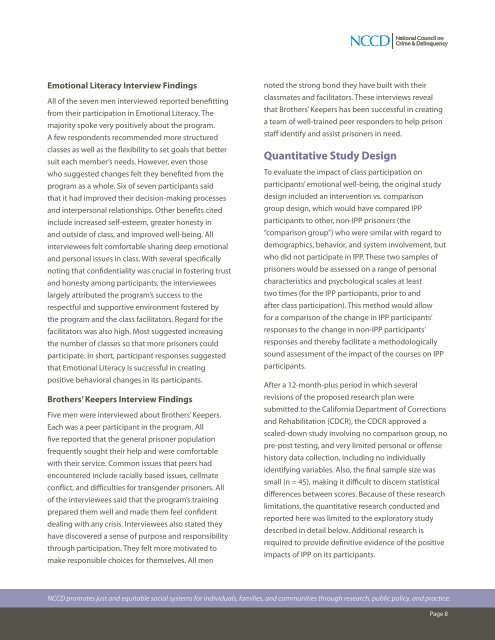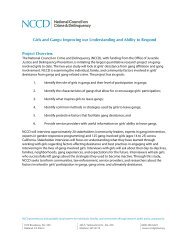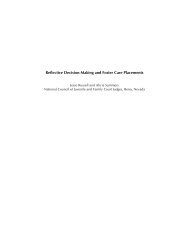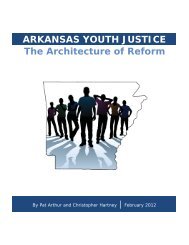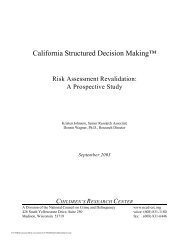Evaluation of the Insight Prison Project - National Council on Crime ...
Evaluation of the Insight Prison Project - National Council on Crime ...
Evaluation of the Insight Prison Project - National Council on Crime ...
You also want an ePaper? Increase the reach of your titles
YUMPU automatically turns print PDFs into web optimized ePapers that Google loves.
Emoti<strong>on</strong>al Literacy Interview Findings<br />
All <str<strong>on</strong>g>of</str<strong>on</strong>g> <str<strong>on</strong>g>the</str<strong>on</strong>g> seven men interviewed reported benefitting<br />
from <str<strong>on</strong>g>the</str<strong>on</strong>g>ir participati<strong>on</strong> in Emoti<strong>on</strong>al Literacy. The<br />
majority spoke very positively about <str<strong>on</strong>g>the</str<strong>on</strong>g> program.<br />
A few resp<strong>on</strong>dents recommended more structured<br />
classes as well as <str<strong>on</strong>g>the</str<strong>on</strong>g> flexibility to set goals that better<br />
suit each member’s needs. However, even those<br />
who suggested changes felt <str<strong>on</strong>g>the</str<strong>on</strong>g>y benefited from <str<strong>on</strong>g>the</str<strong>on</strong>g><br />
program as a whole. Six <str<strong>on</strong>g>of</str<strong>on</strong>g> seven participants said<br />
that it had improved <str<strong>on</strong>g>the</str<strong>on</strong>g>ir decisi<strong>on</strong>-making processes<br />
and interpers<strong>on</strong>al relati<strong>on</strong>ships. O<str<strong>on</strong>g>the</str<strong>on</strong>g>r benefits cited<br />
include increased self-esteem, greater h<strong>on</strong>esty in<br />
and outside <str<strong>on</strong>g>of</str<strong>on</strong>g> class, and improved well-being. All<br />
interviewees felt comfortable sharing deep emoti<strong>on</strong>al<br />
and pers<strong>on</strong>al issues in class. With several specifically<br />
noting that c<strong>on</strong>fidentiality was crucial in fostering trust<br />
and h<strong>on</strong>esty am<strong>on</strong>g participants, <str<strong>on</strong>g>the</str<strong>on</strong>g> interviewees<br />
largely attributed <str<strong>on</strong>g>the</str<strong>on</strong>g> program’s success to <str<strong>on</strong>g>the</str<strong>on</strong>g><br />
respectful and supportive envir<strong>on</strong>ment fostered by<br />
<str<strong>on</strong>g>the</str<strong>on</strong>g> program and <str<strong>on</strong>g>the</str<strong>on</strong>g> class facilitators. Regard for <str<strong>on</strong>g>the</str<strong>on</strong>g><br />
facilitators was also high. Most suggested increasing<br />
<str<strong>on</strong>g>the</str<strong>on</strong>g> number <str<strong>on</strong>g>of</str<strong>on</strong>g> classes so that more pris<strong>on</strong>ers could<br />
participate. In short, participant resp<strong>on</strong>ses suggested<br />
that Emoti<strong>on</strong>al Literacy is successful in creating<br />
positive behavioral changes in its participants.<br />
Bro<str<strong>on</strong>g>the</str<strong>on</strong>g>rs’ Keepers Interview Findings<br />
Five men were interviewed about Bro<str<strong>on</strong>g>the</str<strong>on</strong>g>rs’ Keepers.<br />
Each was a peer participant in <str<strong>on</strong>g>the</str<strong>on</strong>g> program. All<br />
five reported that <str<strong>on</strong>g>the</str<strong>on</strong>g> general pris<strong>on</strong>er populati<strong>on</strong><br />
frequently sought <str<strong>on</strong>g>the</str<strong>on</strong>g>ir help and were comfortable<br />
with <str<strong>on</strong>g>the</str<strong>on</strong>g>ir service. Comm<strong>on</strong> issues that peers had<br />
encountered include racially based issues, cellmate<br />
c<strong>on</strong>flict, and difficulties for transgender pris<strong>on</strong>ers. All<br />
<str<strong>on</strong>g>of</str<strong>on</strong>g> <str<strong>on</strong>g>the</str<strong>on</strong>g> interviewees said that <str<strong>on</strong>g>the</str<strong>on</strong>g> program’s training<br />
prepared <str<strong>on</strong>g>the</str<strong>on</strong>g>m well and made <str<strong>on</strong>g>the</str<strong>on</strong>g>m feel c<strong>on</strong>fident<br />
dealing with any crisis. Interviewees also stated <str<strong>on</strong>g>the</str<strong>on</strong>g>y<br />
have discovered a sense <str<strong>on</strong>g>of</str<strong>on</strong>g> purpose and resp<strong>on</strong>sibility<br />
through participati<strong>on</strong>. They felt more motivated to<br />
make resp<strong>on</strong>sible choices for <str<strong>on</strong>g>the</str<strong>on</strong>g>mselves. All men<br />
noted <str<strong>on</strong>g>the</str<strong>on</strong>g> str<strong>on</strong>g b<strong>on</strong>d <str<strong>on</strong>g>the</str<strong>on</strong>g>y have built with <str<strong>on</strong>g>the</str<strong>on</strong>g>ir<br />
classmates and facilitators. These interviews reveal<br />
that Bro<str<strong>on</strong>g>the</str<strong>on</strong>g>rs’ Keepers has been successful in creating<br />
a team <str<strong>on</strong>g>of</str<strong>on</strong>g> well-trained peer resp<strong>on</strong>ders to help pris<strong>on</strong><br />
staff identify and assist pris<strong>on</strong>ers in need.<br />
Quantitative Study Design<br />
To evaluate <str<strong>on</strong>g>the</str<strong>on</strong>g> impact <str<strong>on</strong>g>of</str<strong>on</strong>g> class participati<strong>on</strong> <strong>on</strong><br />
participants’ emoti<strong>on</strong>al well-being, <str<strong>on</strong>g>the</str<strong>on</strong>g> original study<br />
design included an interventi<strong>on</strong> vs. comparis<strong>on</strong><br />
group design, which would have compared IPP<br />
participants to o<str<strong>on</strong>g>the</str<strong>on</strong>g>r, n<strong>on</strong>-IPP pris<strong>on</strong>ers (<str<strong>on</strong>g>the</str<strong>on</strong>g><br />
“comparis<strong>on</strong> group”) who were similar with regard to<br />
demographics, behavior, and system involvement, but<br />
who did not participate in IPP. These two samples <str<strong>on</strong>g>of</str<strong>on</strong>g><br />
pris<strong>on</strong>ers would be assessed <strong>on</strong> a range <str<strong>on</strong>g>of</str<strong>on</strong>g> pers<strong>on</strong>al<br />
characteristics and psychological scales at least<br />
two times (for <str<strong>on</strong>g>the</str<strong>on</strong>g> IPP participants, prior to and<br />
after class participati<strong>on</strong>). This method would allow<br />
for a comparis<strong>on</strong> <str<strong>on</strong>g>of</str<strong>on</strong>g> <str<strong>on</strong>g>the</str<strong>on</strong>g> change in IPP participants’<br />
resp<strong>on</strong>ses to <str<strong>on</strong>g>the</str<strong>on</strong>g> change in n<strong>on</strong>-IPP participants’<br />
resp<strong>on</strong>ses and <str<strong>on</strong>g>the</str<strong>on</strong>g>reby facilitate a methodologically<br />
sound assessment <str<strong>on</strong>g>of</str<strong>on</strong>g> <str<strong>on</strong>g>the</str<strong>on</strong>g> impact <str<strong>on</strong>g>of</str<strong>on</strong>g> <str<strong>on</strong>g>the</str<strong>on</strong>g> courses <strong>on</strong> IPP<br />
participants.<br />
After a 12-m<strong>on</strong>th-plus period in which several<br />
revisi<strong>on</strong>s <str<strong>on</strong>g>of</str<strong>on</strong>g> <str<strong>on</strong>g>the</str<strong>on</strong>g> proposed research plan were<br />
submitted to <str<strong>on</strong>g>the</str<strong>on</strong>g> California Department <str<strong>on</strong>g>of</str<strong>on</strong>g> Correcti<strong>on</strong>s<br />
and Rehabilitati<strong>on</strong> (CDCR), <str<strong>on</strong>g>the</str<strong>on</strong>g> CDCR approved a<br />
scaled-down study involving no comparis<strong>on</strong> group, no<br />
pre-post testing, and very limited pers<strong>on</strong>al or <str<strong>on</strong>g>of</str<strong>on</strong>g>fense<br />
history data collecti<strong>on</strong>, including no individually<br />
identifying variables. Also, <str<strong>on</strong>g>the</str<strong>on</strong>g> final sample size was<br />
small (n = 45), making it difficult to discern statistical<br />
differences between scores. Because <str<strong>on</strong>g>of</str<strong>on</strong>g> <str<strong>on</strong>g>the</str<strong>on</strong>g>se research<br />
limitati<strong>on</strong>s, <str<strong>on</strong>g>the</str<strong>on</strong>g> quantitative research c<strong>on</strong>ducted and<br />
reported here was limited to <str<strong>on</strong>g>the</str<strong>on</strong>g> exploratory study<br />
described in detail below. Additi<strong>on</strong>al research is<br />
required to provide definitive evidence <str<strong>on</strong>g>of</str<strong>on</strong>g> <str<strong>on</strong>g>the</str<strong>on</strong>g> positive<br />
impacts <str<strong>on</strong>g>of</str<strong>on</strong>g> IPP <strong>on</strong> its participants.<br />
NCCD promotes just and equitable social systems for individuals, families, and communities through research, public policy, and practice.<br />
Page 8


